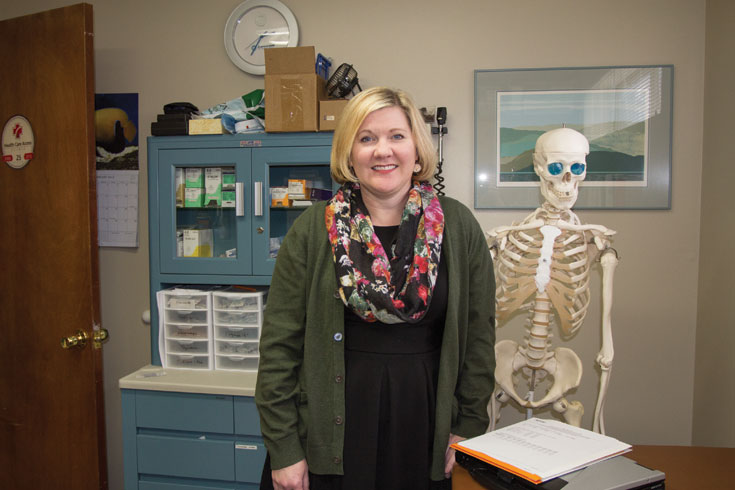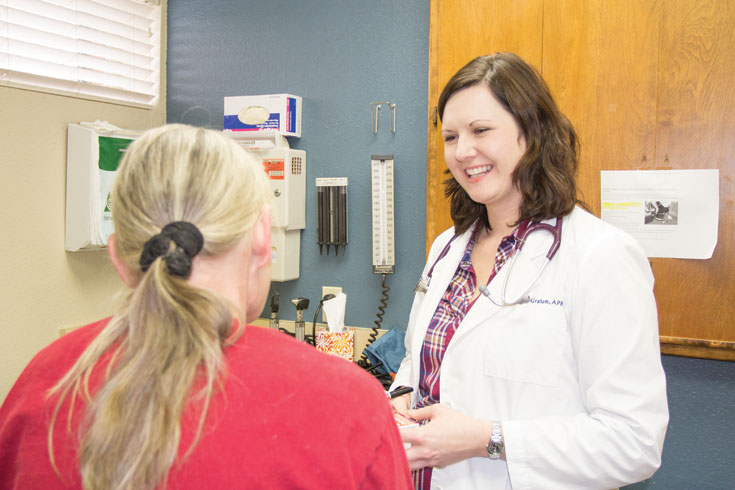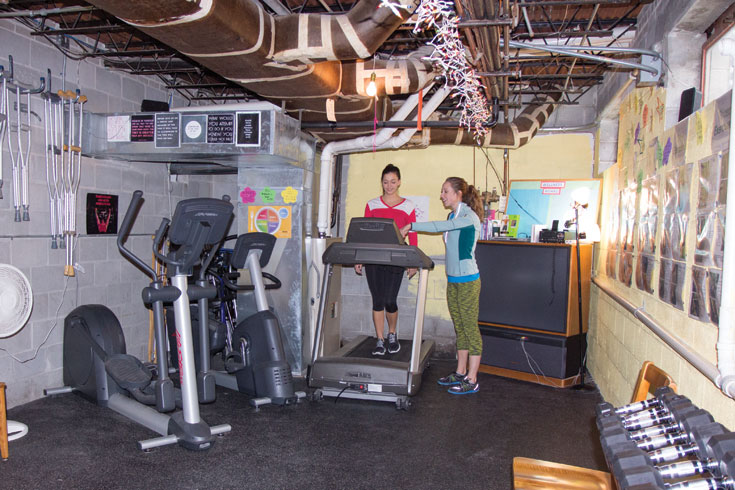| 2015 Q1 | story by TARA TRENARY | photos by STEVEN HERTZOG |

Haylee Fulmer, volunteer from the University of Kansas, works out with Wellness Coordinator Nikki Ingersoll.
Scott Swedlund knows what it’s like to struggle. Though he says he’s blessed today, it wasn’t always that way. About 20 years ago, he worked two jobs just to survive and try to save money for college. He had no health insurance through his work, didn’t qualify for insurance under his parents and wasn’t eligible for government assistance. And he got sick, really sick.
A friend introduced Swedlund, now a sales manager with Cumulus Media and a local small business owner, to Health Care Access, a health care option for low-income, uninsured Douglas County residents. He had pneumonia and no doctor, and going to the emergency room wasn’t an option for him. He knew how easily a simple emergency room visit could sink him financially and take away his college dreams.
Not only did Health Care Access treat Swedlund and provide him with the medicine he needed free of charge, it also saved his life—literally.
“I wasn’t made to feel poor; I wasn’t made to feel like I was receiving a handout,” he said. “They treated me with dignity. I have a debt to them that I’ll never be able to repay.”
Health Care Access, a nonprofit organization that provides primary health care and wrap-around services to community members who can’t afford health insurance and don’t qualify for government assistance, began in 1988 in a retirement community as a short-term solution for low-income citizens. Starting with one volunteer and $500 as a grassroots effort in the medical community, Health Care Access now offers a variety of services, including primary care, mental-health counseling, a wellness program, prescription assistance, an early-detection program for women aged 40 to 64 and referrals to specialists.
“We are the clinic for residents who have nowhere else to turn,” said Kim Polson, interim director of Health Care Access. “We help this population manage their long-term health.”
Health Care Access is made up of 13 paid employees and approximately 40 active volunteers. The clinic consists of two NPs (nurse practitioners); two RNs (registered nurses); one CMA (certified medical assistant); one LSCW (licensed clinical social worker); one pharmacy technician; one wellness coordinator and two receptionists. The administration has an interim director, an administrative assistant and a development coordinator. Among the volunteers are 15 active medical providers, including MDs (medical doctors); DOs (doctors of osteopathy); APRNs (advanced practice registered nurses); PAs (physician’s assistants) and others.

Kim Polson, Interim Director of Health Care Access
There is also a 14-member board made up of community members that provides leadership and governance, and helps with priorities to be executed by the executive director, who’s in charge of implementation and reporting. At least one position is reserved for a physician, and the medical director and pharmacist-in-charge are considered ex-officio members.
“It’s a wonderful bunch of individuals,” said Libby Graham, APRN and clinic coordinator, who manages the clinic staff. “Everybody who’s here wants to be here and feels a calling to the mission.”
The mission Graham speaks of is Health Care Access’s goal to “help facilitate access to health services for Douglas County, Kansas, residents with limited financial means who are not covered by private or governmental insurance programs.” All of Health Care Access employees strive to serve this mission.
Along with needing basic health-care access, many patients have no place to live and no food, have lost a job, need crisis management or help with mental-health needs. Health Care Access can help them with all of these issues.
“We try to figure out a better plan for their future,” Graham said.
Figuring out a better plan for patients’ futures consists of diagnosing and treating the acute and chronic health issues of between 20 to 50 patients a day, and prescribing medications for those patients. The Patient Assistance Program offered by Health Care Access helps patients get expensive medications at no charge. It also consists of identifying patients’ other needs, such as mental-health or substance-abuse issues, and helping them navigate how best to deal with those issues.
“We help them access community resources,” Graham said.
One major challenge, she points out, is patient compliance. Many patients don’t follow up with doctors and take charge of their health; missing medications, doctor’s appointments and not attending physical-therapy sessions.
“A lot of the time it ends up being a lack of knowledge by the patients,” she explained. “It can be a challenge to see people in such a bad situation. [But] we have to put the ball back in their court.”
Along with being an NCQA (National Committee for Quality Assurance)-recognized patient-centered medical home to its patients, Health Care Access is the only primary-care practice in town with an on-site Wellness Center. The Wellness Center provides education and guidance on exercise and nutrition, with much of the exercise equipment donated by local businesses and generous community members. The programs are designed for patients’ specific health needs and geared toward getting them safely to their goals.
“We do our best to facilitate a working environment where they [patients]feel welcome and can achieve their goals,” said Nikki Ingersoll, Health Care Access Wellness Coordinator. “The idea is that when they get insurance, they can take that knowledge and do it on their own.”
Keeping patients on track with exercise and nutrition is not without its challenges.
“They take one step at a time,” Ingersoll continues. “This is a demographic that is underserved. It’s extremely important that we provide care so they can get back on their feet and start living their lives.”
Getting patients back on their feet is no easy task, especially in a state where 12.6 percent – approximately 359,000 – of Kansans do not have insurance, according to the most recent numbers in 2013 from the Kansas Health Institute’s Annual Insurance Update 2014.

Libby Graham, APRN, discusses medications with patient at Health Care Access.
Other than those with private plans, which is more than half in 2013, Kansans obtain health insurance through public-health programs, such as Medicare, Medicaid, the Children’s Health Insurance Program and the Veterans Administration “- about 30 percent.” Among adult Kansans between 19 and 64 years old, about 12 percent have public insurance, while more than 17 percent have no insurance. More than a third of children in Kansas receive public coverage. About 60 percent of all uninsured Kansans are between the ages of 19 and 44, and more than 40 percent of adult Kansans with incomes below the federal poverty level are uninsured.
The Affordable Care Act (ACA), established in 2010, requires all U.S. citizens to have health insurance. It created the Health Insurance Marketplace, by which private insurance companies sell insurance plans. At the end of open enrollment in 2015, 96,226 Kansas consumers had chosen a plan or had been automatically re-enrolled in Marketplace coverage, 80 percent of which qualified for a tax credit through the Marketplace.
However, approximately 182,000 Kansans fall into what is called an “eligibility gap,” including adults whose income is too high for Medicaid eligibility but too low to qualify for premium tax credits through the Marketplace. Of that 182,000, 78,400 of those Kansans have no health insurance, with nearly half in the gap being employed.
Because of the Supreme Court’s 2012 ACA ruling that Medicaid expansion be optional for states, Kansas and 24 other states have chosen not to expand Medicaid, creating a gap between existing Medicaid eligibility and eligibility for premium tax credit assistance.

Nikki Ingersoll and Haylee Fuhmer see Fuhmer’s progress on the treadmill.
“While these employees now have access to individual insurance on the Marketplace, the cost of that coverage is out of reach,” Polson said. “While HCA helps navigate patients to insured status whenever we can, our focus is providing quality primary care to those who remain caught in the coverage gap and those who fall through the cracks.”
Therefore, Health Care Access exclusively serves those uninsured Douglas County residents who are less than 200 percent of the federal poverty level guidelines – approximately $48,500 per year for a family of four. This makes the organization more dependent on grants and fund-raising.
“We have great support from LMH [Lawrence Memorial Hospital], its affiliated groups and the local medical community, but the costs for uninsured individuals are still a challenge,” Polson said.
Health Care Access is financed by in-kind contributions – the largest portion of which comes from Lawrence Memorial Hospital – state, city and county grants, fund-raisers, personal contributions from community members and some patient fees – the smallest portion. These patient fees are calculated on a sliding scale and run about $10 to $15 per appointment, no more than $20 per day. Community organizations and individuals also donate medical and fitness equipment and supplies.
Health Care Access patients face tough choices every day, and one of the biggest is making their health a priority.
“If someone’s not well, they can’t contribute to our community,” Polson said. “And as most parents do, they will forego their own care to provide for their families.”
Health Care Access, officers, employees and volunteers hope they can change that.
“You never know when you’re going to end up needing help,” Graham said. “If we weren’t here, they wouldn’t have anyplace to go.”
Former patient and board member Swedlund knows this all too well.
“HCA is for people who fall through the cracks. It’s not a handout, it’s a hand up,” he said. “They gave me a chance to repay that debt through work and participation.”
He vowed to give back when he was able, and though he only used Health Care Access a few times when he was sick with pneumonia, he has never forgotten what it did for him and knows how important it is to this community.
“Most people are one diagnosis from disaster,” Swedlund said. “The people who are most at risk do not fit any stereotype. They are your friends and neighbors. HCA is the safety net to those who don’t have access to health insurance, dignity and care.”
For more information on Health Care Access and its services, visit www.healthcareaccess.org.
